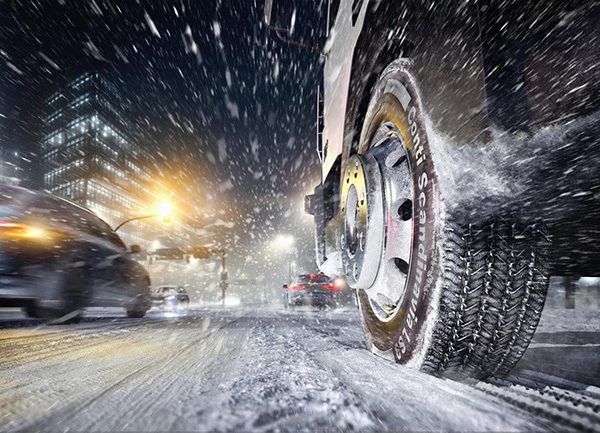
With legal stipulations governing winter equipment on trucks and buses differing across many European countries, Continental has released an updated country-by-country guide listing seasonal tyre regulations as required across Europe.
Ahead of the upcoming changeover window to winter tyres, Continental has compiled a summary of the winter tyre current regulations – including the most important changes – for truck and bus/coach drivers and fleet managers.
In the United Kingdom, Denmark, Italy and the Netherlands, for example, there remains no general obligation to fit winter tyres on commercial vehicles. By contrast, Germany, Austria and Spain have put specific regulations in place for the fitment of winter tyres. France has tightened up their winter equipment regulations for 2021, similar to Norway.
Continental’s new Tackle Winter with Confidence guide explores the demands placed on tyres by wintry road conditions and provides useful tyre knowhow for the winter season. And the tyre manufacturer has rounded off its wide-reaching winter portfolio with the Scandinavia Generation 3 winter tyre line. These tyres are designed to handle extremely tough winter conditions and boast high levels of traction without compromising on mileage. Continental provides a compelling proposition for its customers as an international solutions and service expert – with both its range of new products and an array of retreaded tyres. New retread products have been added to the winter tyre portfolio.
Important changes to winter tyre requirements in four countries
In some of Europe’s key transit countries – such as Germany, Austria, Switzerland, Belgium and Poland – no changes have been made to the winter equipment requirements for trucks and buses compared to last year. In France, winter equipment is already mandatory on specially marked roads. A new rule now explicitly refers to the 3PMSF marking instead of only to the M+S marking and affects passenger cars as well as commercial vehicles. From 1.11-31.03. at the discretion of the individual “départements” winter equipment stipulations apply on certain roads signalled by the road signs B26 [snow chains mandatory] and B58/B59 [winter tyres mandatory]:
Trucks without trailers and buses must carry snow chains for fitment on at least two driven wheels or have at least two steered wheels for the main steering system and at least two driven wheels fitted with tyres in M+S and 3PMSF marking (until 01.11.2024 tyres with either M+S or 3PMSF specification are still accepted). Trucks with trailers must carry snow chains for fitment on at least two driven wheels.
This regulation applies from November 1 until March 31 at the discretion of the local authorities. Already since the 2020/2021 season, Norway has required winter tyres with the 3PMSF symbol for the drive axle and the front steer axle. Free-rolling axles must be fitted with tyres bearing the 3PMSF symbol or M+S marking.
Further development of the proven Scandinavia tyre family
Information on winter equipment requirements is important, but choosing the right tyres is even more so. Continental has rounded off its extensive range of winter tyres for commercial vehicles for the 2021/22 winter season with a 22.5-inch tyre. “We have developed the Scandinavia Generation 3 tyre line for a broad range of road surfaces and all weather conditions,” explains Hinnerk Kaiser, Head of Tire Development at Continental. This family of tyres impress with their outstanding traction in winter conditions combined with a long lifespan. Optimised compounds provide excellent grip on snow, ice and in the wet without compromising in terms of mileage, wear or tread durability. “Our two-stage siping technology offers our customers all-round safety all year round,” adds Kaiser. “The tyres provide secure performance in challenging weather conditions during the winter months and also help to enhance safety and efficiency in summer with their optimised rolling resistance and high mileage capability.” The Scandinavia line from Continental is therefore a safe bet for all axle positions and sizes. “The high natural rubber content of our tyres gives them lower rolling resistance and the required flexibility in low temperatures,” says Kaiser. Optimised filler and oil content ensures better wear properties and therefore sustainability and efficiency.
This product line does everything required of a specialist tyre for extreme winter use. But it also safely covers all the bases as an all-rounder for the variety of conditions presented during the winter months. The Generation 3 tyres – the Conti Scandinavia HS3, HD3 and HT3 – are therefore equipped to contribute significantly to the operational safety of vehicles in a wide range of road and weather conditions. “We have pooled together our tyre expertise for the Generation 3 winter tyre family and employed new technologies to increase performance beyond existing boundaries,” says Kaiser.
Continental provides an overview of the current regulations for winter tyres at https://www.continental-tyres.co.uk/truck/knowhow/european-winter-regulations
Source: Tyretradenews




























